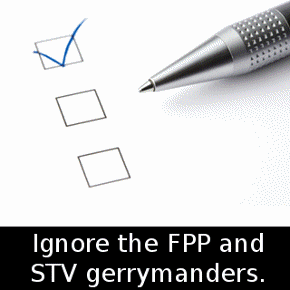Why National prefers a supplementary member voting system
Updated
Should there be a binding referendum on MMP, and a subsequent decision is made to choose an electoral system, there should be some prior discussion on these electoral systems. National prefers the proportional-lite Supplementary Member (SM) system because it dilutes the representative power of the left as it will reduce its proportion of seats in the House, in part to those parties who hover just under the 5 percent threshold but get no seats.
Currently we have 52 list seats. Based on 50 list seats, if the the Greens got six percent, and no electorate seats they'd get just three seats under SM. If the list seats were reduced to 12 percent of all seats, they'd be out of Parliament under SM..
So what is SM? Here's a brief post on the four electoral systems I believe we'll be choosing from should the initial referendum be successful.
Most people are aware on how First Past the Post (FPP) works. Selected candidates who gets the highest votes in each electorate are elected and the party in power is the party with the most elected candidates. Similarly most are aware that the party vote determines the number of seats in a Mixed Member Proportional ( MMP) system, with elected candidates dropping off the list.
Single Transferable Vote (STV) is a preferential voting system designed to minimise wasted votes and provide proportional representation based on electorate seats, as voters are choosing between candidates, not parties. Candidates are ranked, and votes are transferred to minimise waste. This system reduces the role of political parties as candidates of one party can be elected on transfers from voters for candidates in other parties.
The National-supported SM system, compared with MMP, switches the voting power between list and electoral seats as electoral seats make up the bulk of Parliament and the remainder are proportionatly filled from the party list vote. It's FPP with a proportional representation tag-on. You still have two votes but the electoral vote is the key vote. It gives more power to the larger parties than STV or MMP but not as much as FPP. It also means that MPs are less likely to return back on the list if they are voted out at an election.
Under SM, the key issue for small parties is what proportion of the seats are to be declared list seats. The reason National likes this system is that smaller parties have a substantially smaller proportion of their share of the vote and don't need to be relied on as much as within MMP to form a government.
If we changed to SM, two parties will benefit: National and Labour -with National benefiting more than Labour. (Update and most minor parties that hover under the 5% threshold - the Christian Coalition with 4.6% would have got into Parliament in1996 under SM). However the Maori Party could get an extra seat if more realise that both their list and electorate vote will count. In achieving this it could reduce Labour's list vote.It also means that those who are not on the Maori roll and want to list vote the Maori Party will not have their vote wasted.
It will also substantially reduce the number of seats of any party that gets into party with a list vote just over the five percent threshold and no seats like NZ First and the Greens currently have - and that's the real reason why National prefers SM.
So in summary, with FPP, seats are based on the elected constituents, with STV it is the constituent vote plus the transfers. With MMP proportionality is confined to the list and with SM proportionality is confined only to list seats above the number of coinsituent seats.
Which system do you prefer?
Labels: MMP, National, referendum




3 Comments:
Geographical Proprtional FPP?
(so that each electorate covers the same area)
But really, any serious look at NZ's electoral system needs to consider more than e.g. geographic vs demographic FPP. For example: should we have a taxpayer qualification? should beneficiaries be allowed to vote (there is a clear conflict of interest and moral hazard there). the same applies to civil servants.
A geographically proportionate FPP system, with taxpayer franchise, strong conflict-of-interest restrictions - would clearly have produced a much more productive and efficient NZ
should we have a taxpayer qualification?
No
should beneficiaries be allowed to vote
Yes
the same applies to civil servants.
No
I actually can't believe I'm reading this. "The Right" have put in a lot of effort to drive the "whats in it for me" attitude when it comes to selecting and now you want to block out those that are "self interested"?
I prefer Open List Proportional Representation. We should lower the party vote threshold from 5% to 1% so that minor parties that aren't just vehicles for former-Labour and former-National MPs can get into parliament.
We should keep two votes. One for the party and one for the person.
The party vote would still determine what proportion of seats each party that gets over 1% receives.
All electorates should be abolished and people can select the person that they want to vote for from any party's list.
For example, if the Greens won 5% of the party vote they would be entitled to 6 MPs (5% of 120 is 6). Instead of choosing the 6 MPs themselves as they do now they would get the 6 Green Party list candidates who received the highest number of person votes.
This system keeps proportionality, allows new minor parties to enter parliament, removes the problem of overhangs, and also removes the MMP problem of some MPs not being directly elected by the public.
Post a Comment
Subscribe to Post Comments [Atom]
<< Home